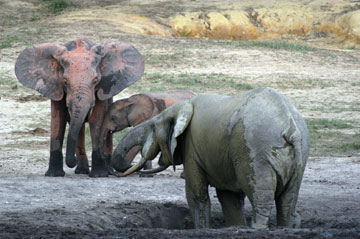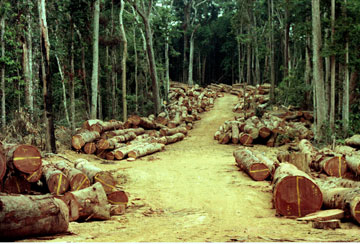Congo forest elephants declining due to logging roads, illegal ivory trade
Congo forest elephants declining from logging roads, illegal ivory
Rhettt A. Butler, mongabay.com
April 1, 2007
Fast-expanding logging roads in the Congo basin are becoming “highways of death” for the fierce but elusive forest elephant, according to a new study published in the journal Public Library of Science. Logging roads both provide access to remote forest areas for ivory poachers and serve as conduits of advancing human settlement.
“Unmanaged roads are highways of death for forest elephants,” said Wildlife Conservation Society biologist Dr. Stephen Blake, the study’s lead author. “It is not the physical effect of the road that is the issue — forest elephants actually like roadside vegetation — rather it is the fact that unmanaged roads bring people, with their guns and ammunition. They also become direct pipelines into pristine forest areas for both human settlement and distant bushmeat markets.”
Walking over 6000 kilometers (3,700 miles) in five countries, and covering more than 68,000 square kilometers (26,000 square miles) in systematic surveys, a team of researchers found that elephant abundance declined near roadways, largely the result of heavy poaching for the ivory trade. Despite international laws regulating ivory, the trade has expanded in recent years due to rising demand from China.
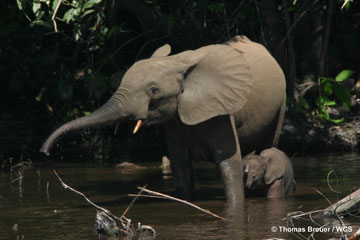
Top: Forest elephants in the Mbeli River, Nouabale-Ndoki National Park, Congo (Photo courtesy of WCS). Middle: Family of forest elephants (Photo by Richard Ruggiero). Bottom: Abeilles logs awaiting to be picked up by logging trucks (Photo by Richard Ruggiero). Images courtesy of WCS. |
Altogether, the researchers found 53 confirmed elephant poaching camps and 41 elephant carcasses (of which 27 carcasses were confirmed as having been poached). They found a marked decrease in elephant abundance near roads.
“The encounter rate of poached elephant carcasses decreased with distance from the nearest road… and no poached carcasses were found beyond 45 km of a road,” they wrote.
The researchers said that while the effects of roads were evident in national park areas, protected areas appeared to reduce the overall amount of poaching. The results suggest that steps to minimize road construction while at the same time setting aside more protected areas could be a good stategy to protect the increasingly threatened forest elephant.
“Our results indicate that a combination of illegal killing and other human disturbance has had a profound impact on forest elephant abundance and distribution, including inside national parks (NPs),” they wrote. “[But] Megatransect data suggest strongly that NPs and protected areas are making a positive contribution to conservation because at any given distance from the nearest road, protected areas have (1) lower incidence of human sign, and (2) higher incidence of forest elephant sign than nonprotected forest, at least in Congo and Gabon.”
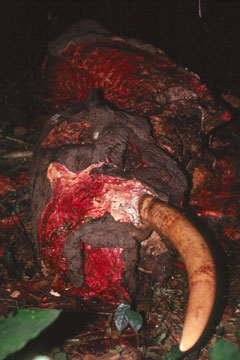
Top: Butchered elephant carcass in the Congo rainforest (Photo by Richard Ruggiero). Bottom: an elephant poacher waits after being caught with an elephant carcass (Photo by Richard Ruggiero). |
Blake and colleagues say that forest elephants will continue to decline unless four actions are immediately and successfully implemented: (1) a national and region-wide approach to road development planning and construction is needed to reduce fragmentation of key elephant habitat; (2) strict anti-poaching laws much be enforced; (3) the illegal invory trade “must be brought under control in elephant-range states, transit countries, and destination nations”; and (4) private-sector logging and mining companies must be recruited to reduce their negative impacts in and around protected areas. The authors note that private firms are known to illegally encroach on national parks.
The authors say the while savanna elephant populations appear to be on the upswing, the case is very different for forest elephants, which are smaller, have shorter straighter tusks, and are confined to the dark recesses of tropical forests in West and Central Africa.
“Even with a near-universal ban of the trade in ivory in place, forest elephant range and numbers are in serious decline,” they wrote. “This is in contrast to much of the recent literature on “the African elephant” that indicates generally stable or increasing populations in Eastern and Southern Africa, and in some cases, dramatic population growth and a “return of the giants.”
“The decline of the ecologically, socially, morphologically, and genetically distinct forest elephant… has profound implications for the diversity and resilience of the African elephant. Given their vulnerability compared to savannah elephants, the wellbeing of forest elephants must be given priority when making decisions about elephant management on the continental scale.”
“In African savannahs, both elephant populations and illegal killing can often be monitored through aerial surveys, whereas elephant massacres in the depths of the forest can remain undetected,” added Dr. Blake. “The funding for elephant management in central Africa is much smaller by comparison to those that are available in other regions such as South Africa, where elephants can be adequately protected.”
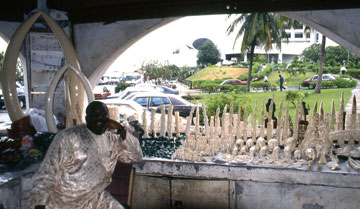
Ivory seller in Lagos, Nigera (Photo by Dan Stiles). |
The elephant research was conducted under the auspices of the Monitoring of the Illegal Killing of Elephants (MIKE) program and was funded by the European Commission, WWF, WCS and the United States Fish and Wildlife Service African Elephant Conservation Fund. The study is the first major scientific survey of forest elephants since 1989, when their population was estimated at approximately 170,000 individuals. Since then, no further region-wide surveys have been made, despite large-scale increases in logging, road building, human populations, and civil unrest.
Citation: Blake S, Strindberg S, Boudjan P, Makombo C, Bila-Isia I, et al. (2007) Forest elephant crisis in the Congo Basin. PLoS Biol 5(4): e111. doi:10.1371/journal.pbio.0050111
Related
When elephants attack. Surviving an elephant charge in the Congo rainforest of Gabon.
Slightly smaller than their more familiar relative, the savanna elephant, forest elephants are generally shy animals confined to the dark recesses of tropical forests in West and Central Africa. Here in Loango, where forest is interspersed with savanna, these pachyderms sometimes appear in plain sight as they move across grassy zones and swampy meadows. However, at the first hint of danger, they move back into the protective cover of the forest where they blend surprisingly well into the shadows.



